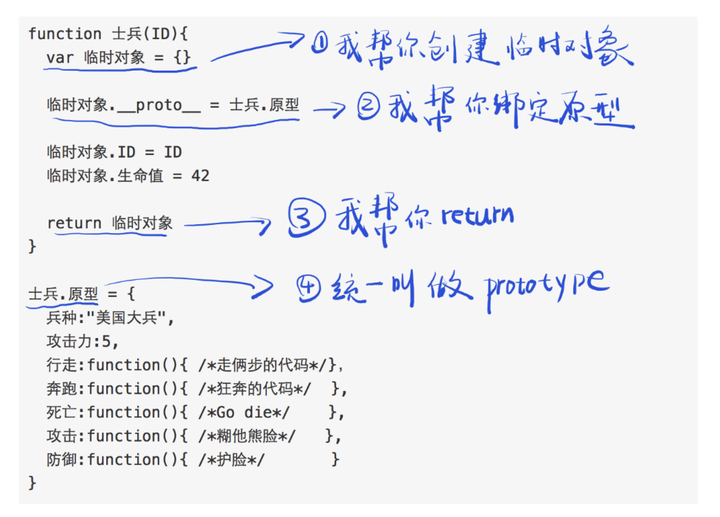JavaScript is a bit confusing for developers experienced in class-based languages (like Java or C++), as it is dynamic and does not provide a class implementation per se (the class keyword is introduced in ES2015, but is syntactical sugar, JavaScript remains prototype-based).
When it comes to inheritance, JavaScript only has one construct: objects. Each object has a private property which holds a link to another object called its prototype. That prototype object has a prototype of its own, and so on until an object is reached with null as its prototype. By definition, null has no prototype, and acts as the final link in this prototype chain.
Nearly all objects in JavaScript are instances of Object which sits on the top of a prototype chain.
While this confusion is often considered to be one of JavaScript's weaknesses, the prototypal inheritance model itself is, in fact, more powerful than the classic model. It is, for example, fairly trivial to build a classic model on top of a prototypal model.
JavaScript对于那些经历过以类为基础的语言(Java或者C++)的人可能有一点迷惑,它是动态的并且不提供类的实现(ES2015中类的实现是一个基于prototype的语法糖)
讨论继承的时候,JavaScript只有一个结构,object(对象),每个对象都有一个私有属性,这个属性指向另一个对象, 称为 它的 Prototype,那个prototype对象也有自己的prototype,如此如此,直到一个对象最终到达null为它的原型,通过定义,null没有原型,并且被认为是这个原型链中的最后一层link。
几乎所有的javascript中的object都是继承自Object,Object位于原型链的顶端。
这个迷惑的地方经常被认为是Javascript语言的一大弱点,基于原型的继承模型,事实上,这个模型比经典模型更加Powerful,是的,完全可以基于原型模型来建立经典模型。
——————————————————————————————————————————————————————————————————
Inheritance with the prototype chain
Inheriting properties
JavaScript objects are dynamic "bags" of properties (referred to as own properties). JavaScript objects have a link to a prototype object. When trying to access a property of an object, the property will not only be sought on the object but on the prototype of the object, the prototype of the prototype, and so on until either a property with a matching name is found or the end of the prototype chain is reached.
Following the ECMAScript standard, the notation someObject.[[Prototype]]is used to designate the prototype of someObject. Since ECMAScript 2015, the [[Prototype]] is accessed using the accessors Object.getPrototypeOf() and Object.setPrototypeOf(). This is equivalent to the JavaScript property __proto__ which is non-standard but de-facto implemented by many browsers.
It should not be confused with the func.prototype property of functions, which instead specifies the [[Prototype]] to be assigned to all instances of objects created by the given function when used as a constructor. The Object.prototype property represents the Object prototype object.
Here is what happens when trying to access a property:
JS中万物皆对象。
通过原型链继承
继承属性
javascript的object是属性的动态'bag',javascript object有通向prototype object 的链接,当尝试访问一个object的属性时,这个属性不光会被在object上寻找,还会这个object的原型上查找,原型的原型,直到原型链的末端,直到找到这个属性的名字。
通过ECMAScript标准,someObject.[[Prototype]]用来指定某个someObject 的原型,从ES2015规范(ES6实现)开始,[[Prototype]]通过Object.getPrototypeOf()和Object.setPrototypeOf()来访问,这等价于JavaScript的__proto__属性,这个属性是不标准的,但事实上被很多浏览器实现了。
函数的func.prototype 等价于 它实例出来的对象的__proto__属性
when you call
var o = new Foo();
JavaScript actually just does
var o = new Object();
o.[[Prototype]] = Foo.prototype;
Foo.call(o)
function 士兵(ID){
var 临时对象 = {}
临时对象.__proto__ = 士兵.原型
临时对象.ID = ID
临时对象.生命值 = 42
return 临时对象
}
士兵.原型 = {
兵种:"美国大兵",
攻击力:5,
行走:function(){ /*走俩步的代码*/},
奔跑:function(){ /*狂奔的代码*/ },
死亡:function(){ /*Go die*/ },
攻击:function(){ /*糊他熊脸*/ },
防御:function(){ /*护脸*/ }
}
// 保存为文件:士兵.js
然后就可以愉快地引用「士兵」来创建士兵了:
var 士兵们 = []
for(var i=0; i<100; i++){
士兵们.push(士兵(i))
}
兵营.批量制造(士兵们)
JS 之父的关怀
JS 之父创建了 new 关键字,可以让我们少写几行代码:

只要你在士兵前面使用 new 关键字,那么可以少做四件事情:
- 不用创建临时对象,因为 new 会帮你做(你使用「this」就可以访问到临时对象);
- 不用绑定原型,因为 new 会帮你做(new 为了知道原型在哪,所以指定原型的名字为 prototype);
- 不用 return 临时对象,因为 new 会帮你做;
- 不要给原型想名字了,因为 new 指定名字为 prototype。
这一次我们用 new 来写
function 士兵(ID){
this.ID = ID
this.生命值 = 42
}
士兵.prototype = {
兵种:"美国大兵",
攻击力:5,
行走:function(){ /*走俩步的代码*/},
奔跑:function(){ /*狂奔的代码*/ },
死亡:function(){ /*Go die*/ },
攻击:function(){ /*糊他熊脸*/ },
防御:function(){ /*护脸*/ }
}
// 保存为文件:士兵.js
然后是创建士兵(加了一个 new 关键字):
var 士兵们 = []
for(var i=0; i<100; i++){
士兵们.push(new 士兵(i))
}
兵营.批量制造(士兵们)
new 的作用,就是省那么几行代码。(也就是所谓的语法糖)
注意 constructor 属性
new 操作为了记录「临时对象是由哪个函数创建的」,所以预先给「士兵.prototype」加了一个 constructor 属性:
士兵.prototype = {
constructor: 士兵
}
如果你重新对「士兵.prototype」赋值,那么这个 constructor 属性就没了,所以你应该这么写:
士兵.prototype.兵种 = "美国大兵"
士兵.prototype.攻击力 = 5
士兵.prototype.行走 = function(){ /*走俩步的代码*/}
士兵.prototype.奔跑 = function(){ /*狂奔的代码*/ }
士兵.prototype.死亡 = function(){ /*Go die*/ }
士兵.prototype.攻击 = function(){ /*糊他熊脸*/ }
士兵.prototype.防御 = function(){ /*护脸*/ }
或者你也可以自己给 constructor 重新赋值:
士兵.prototype = {
constructor: 士兵,
兵种:"美国大兵",
攻击力:5,
行走:function(){ /*走俩步的代码*/},
奔跑:function(){ /*狂奔的代码*/ },
死亡:function(){ /*Go die*/ },
攻击:function(){ /*糊他熊脸*/ },
防御:function(){ /*护脸*/ }
}
完。
function 士兵(ID){
var 临时对象 = {}
临时对象.__proto__ = 士兵.原型
临时对象.ID = ID
临时对象.生命值 = 42
return 临时对象
}
士兵.原型 = {
兵种:"美国大兵",
攻击力:5,
行走:function(){ /*走俩步的代码*/},
奔跑:function(){ /*狂奔的代码*/ },
死亡:function(){ /*Go die*/ },
攻击:function(){ /*糊他熊脸*/ },
防御:function(){ /*护脸*/ }
}
// 保存为文件:士兵.js
然后就可以愉快地引用「士兵」来创建士兵了:
var 士兵们 = []
for(var i=0; i<100; i++){
士兵们.push(士兵(i))
}
兵营.批量制造(士兵们)
JS 之父的关怀
JS 之父创建了 new 关键字,可以让我们少写几行代码:

只要你在士兵前面使用 new 关键字,那么可以少做四件事情:
- 不用创建临时对象,因为 new 会帮你做(你使用「this」就可以访问到临时对象);
- 不用绑定原型,因为 new 会帮你做(new 为了知道原型在哪,所以指定原型的名字为 prototype);
- 不用 return 临时对象,因为 new 会帮你做;
- 不要给原型想名字了,因为 new 指定名字为 prototype。
这一次我们用 new 来写
function 士兵(ID){
this.ID = ID
this.生命值 = 42
}
士兵.prototype = {
兵种:"美国大兵",
攻击力:5,
行走:function(){ /*走俩步的代码*/},
奔跑:function(){ /*狂奔的代码*/ },
死亡:function(){ /*Go die*/ },
攻击:function(){ /*糊他熊脸*/ },
防御:function(){ /*护脸*/ }
}
// 保存为文件:士兵.js
然后是创建士兵(加了一个 new 关键字):
var 士兵们 = []
for(var i=0; i<100; i++){
士兵们.push(new 士兵(i))
}
兵营.批量制造(士兵们)
new 的作用,就是省那么几行代码。(也就是所谓的语法糖)